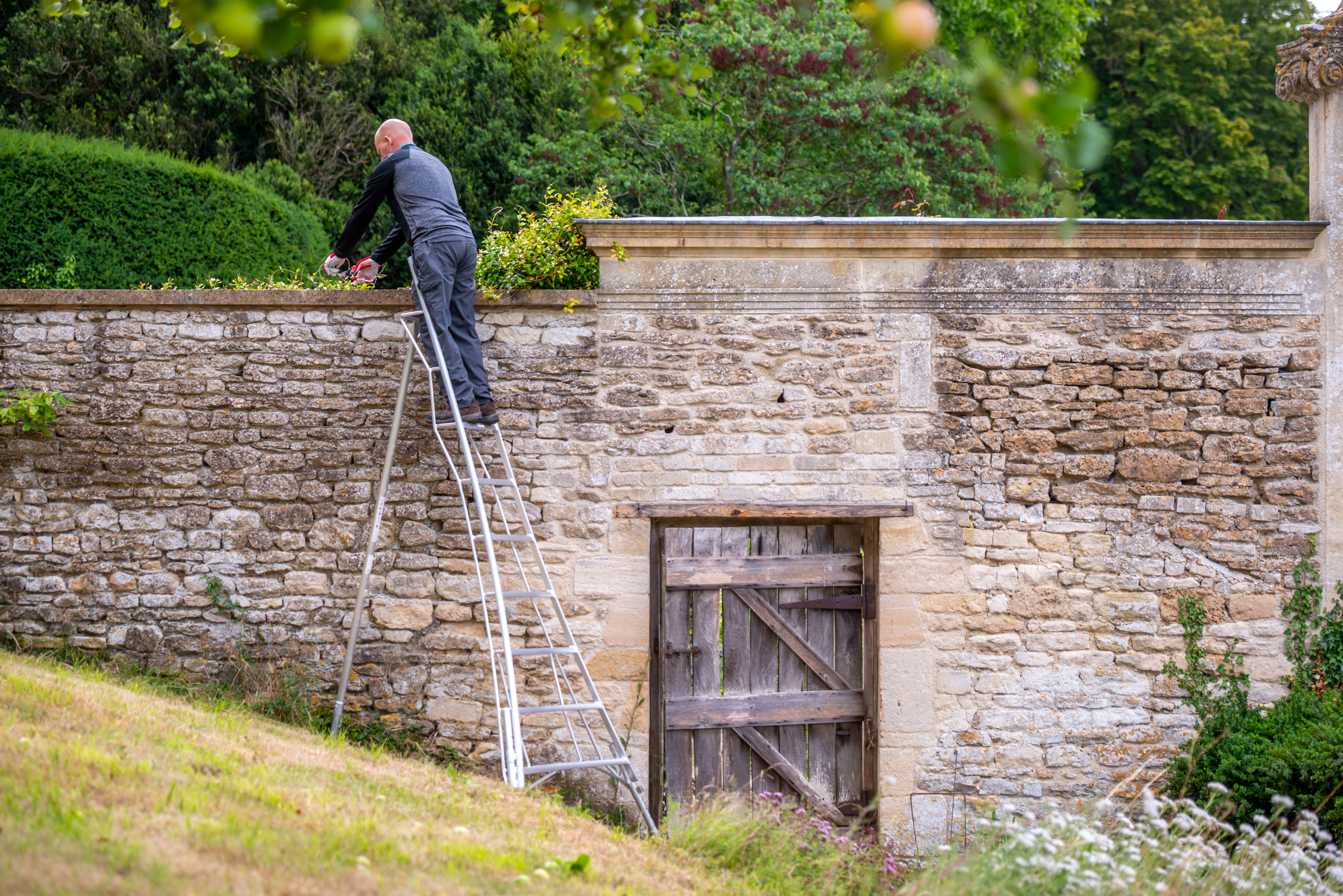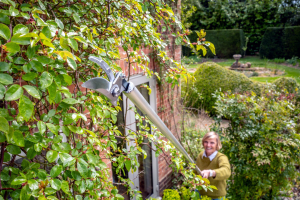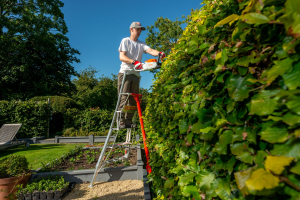A guide to ladder safety and working at heights at home

Working at height causes countless accidents every year - many of which can be avoided by following proper ladder safety procedures.
The risk of falling from ladders is higher than you would think; 48,000 ladder users attend A&E for injuries a year in the UK*.
In this article, we’ll outline some general guidelines to keep you safe when working at heights in and around your home. We will be covering:
Staying safe at height in the home
At Henchman, we’re dedicated to helping you stay safe while working at height. It’s the whole reason we exist!
When our founder took a nasty fall while working in his garden on an unsuitable ladder, his son went on to design the first ever Henchman ladder for his GCSE project.
Since 1994, homeowners and professionals alike have trusted Henchman ladders to keep them safer when working at heights. Henchman has since designed several innovative ladders with a special purpose - safe ladders on any terrain.
The Ladder Association states that, when using a stepladder, all four feet must be firmly on the ground. However, this isn’t always possible, and means that traditional ladders may not always be the right equipment for the job. That’s why we designed our tripod ladders. Our unique 3-leg adjustable design ensures that you’ll have a wobble-free experience when working at height, whatever the task.
While we’ve made a lot of headway in terms of ladder design, there are always risks involved when working at height, and other safety factors you must consider when working at height in and around your home. Let’s explore what these are.
Physical ability & competence
First things first: to use a ladder you need to be physically able and have a good understanding of how to use a ladder safely. You should avoid ladder use if you’ve undergone a recent injury.
Before using a ladder in the home, it’s crucial you understand how to use the equipment safely. In fact, there are a number of ladder training courses available for non-professionals. The more professional training you have, the safer you will be working at height.
Is it safe to use a ladder for the job?
Before you climb your ladder, you need to check if it’s safe to use the ladder for the job you have planned.
While you might need to work at height in order to get your job done, there are many factors that will determine whether or not a ladder is the most suitable or safe equipment to help you reach those heights.
These factors can include:
-
- The terrain
- Uneven or slippery surfaces can increase your chances of falling. Never use a ladder on slippery surfaces and only use ladders on uneven terrain that are designed to deal with it (such as a Henchman tripod ladder or Hi-Step)
- The expected duration of use
- The longer you’re working at height the more chance there is of muscle fatigue. If your ladder is not right for the job, it will increase the speed at which you fatigue.
- If you’re going to be working on a ladder for an extended period of time, pick one with a platform at the top. This will be more comfortable and less fatiguing than balancing on a rung for a long time. WAHR (Working At Height Regulations) states that you should always choose the most appropriate equipment for the job. Our Hi-Step ladder features a 2ft x 2ft enclosed platform, purposely designed for this.
- Never work at height for more than 30 minutes without a break. We recommend taking regular breaks when working at height.
- The weather
- If you’re working outside, poor weather can increase your fall risk. Avoid using ladders when there is damp, rain or wind.
- The activity that you’ll be undertaking
- More strenuous activity can increase your risk of falling, so limit your time on the ladder if the work you’re doing is more physically exerting.
- Risk of falling debris
- Always be cautious of falling debris when using any ladder as impact may destabilise and/or damage the ladder.
- The light and visibility
- Working in hours of limited daylight is dangerous. Make sure you work with enough light indoors or outdoors.
- If you’re working outdoors during hours of sunlight, use skin protection to avoid burning.
- If working indoors, make sure there is enough light to see what you’re doing.
- The terrain
As a general rule, ladders should only be used if you can determine that there’s a low risk of falling. All of the above should be considered.
Remember - in a professional environment, risk assessments look at these considerations to ensure the safety of workers. Unless you ask a professional to carry out a risk assessment for you, you need to be vigilant when assessing your own risk.
If you determine that there’s a higher risk of falling, you should use extra equipment to offer a higher level of fall protection, or engage a professional to do the job instead.
Safety check your ladder before you use it
Ladders must be well maintained in order to ensure your safety. Both wear and tear and degradation can cause your ladder to become less safe over the years, so it’s vital that you check your ladder thoroughly before use. This is especially important if you use your ladder infrequently (every 3-6 months to trim hedges, for example). Read our handy checklist for inspecting your ladder, or read more here.
You should also carry out this pre-use check on brand new ladders.
How to check your ladder is safe for use
A ladder safety check should look for any obvious signs of defects or damage on all parts of the ladder.
As a general rule, the person who’s going to use the ladder should be responsible for this check, as they’re the ones putting themselves at risk. The Ladder Association’s guide recommends carrying out this check at the beginning of the day, and when something has changed, such as the ladder moving to a different area. If you’re unsure or unconfident about how to approach this safety check, you should engage professional help.
As a guideline, you should check the following:
-
- The stiles
- The stiles are the vertical parts that the rungs and steps are attached to.
- Assess if there are any bends, dents, or damage in the stiles. These form a crucial part of the ladder’s stability so any damage could cause the whole structure to fail.
- The rungs/steps
- If the rungs are bent, are too worn, loose or even missing, your ladder could fail.
- If the ladder’s steps are dirty, they could be slippery. Check for any spills of liquid like paint or oil as this will increase the risk of slipping too.
- If the fixings are loose on the steps, they’re vulnerable to collapse.
- The feet
- This is a crucial part of the ladder's stability. If the feet are missing, damaged or worn, your ladder will slip far more easily.
- It’s also important that you check the ladder feet if you move the ladder from soft/dirty ground to a smooth, solid surface. That’s because any mud residue left on the ladder’s feet could cause the ladder to be unstable on the new surface. The same applies if you’re using Henchman rubber feet.
- The locking mechanisms
- If the locking mechanisms (the mechanism that ensures the ladder stay’s upright) are bent or damaged, your ladder could collapse while in use. It’s crucial to check that any locking bars are engaged before mounting the ladder.
- The ladder’s platform (if applicable to your ladder)
- If this section is damaged or buckled, your ladder could become unstable or collapse.
- The ladders joints
- Check for cracks or damage in welded joints
- Check for loose rivets
- The stiles
Using your ladder safely
Once you’ve done your ‘pre-use’ safety check you can climb your ladder. But, there are certain ways to climb and use your ladder that will help minimise your falling risk even further. There are also some things to avoid when using a ladder.
Safety precautions for using a ladder:
-
- Always lean into the ladder when you step onto it
- Make sure you don’t lean back - this is especially important on the Tripod ladders, as this can cause the ladder to lean back and the back leg can swing in causing instability.
- Only carry light materials and tools
- Depending on the type of the ladder you’re using, avoid carrying heavy equipment while working on the ladder.
- Don’t store equipment you don’t immediately need on the ladder’s platform.
- Make sure the ladder is the right height for the task
- This will help you to avoid overreaching or crouching down.
- Always grip the ladder and face the rungs, and lean into the ladder while climbing or descending.
- Never dismount the ladder facing away from the rungs
- Never lean back whilst climbing a ladder
- Always maintain three points of contact with the ladder when climbing it
- A hand and two feet should always have contact with the ladder
- Ascend and descend the ladder slowly
- Maintain the three point contact whenever possible while working on the ladder. If this isn’t possible due to the type of work / equipment you’re using, you need to use two feet and your body supported by the ladder.
- If you must work handsfree, make sure you have other safety measures in place to protect yourself from falling
- You can also use a ladder that allows for hands-free working. Our tripod ladder’s crows nest allows you to lean forward and work handsfree, while the Hi-Step and Wheeled Platforms also allow handsfree work.
- Always lean into the ladder when you step onto it
What to avoid when using a ladder:
-
- Never overreach
- Make sure your body stays within the stiles - if you face away from the stiles you can lose your balance easily.
- Never place ladders on moveable objects - only ever on stable ground.
- Moveable objects can include pallets, bricks, tables, vehicles etc.
- Don’t overload your ladder
- Consider your weight and the equipment you’re carrying before working at height.
- Check the weight restrictions of your ladder in the manual.
- Don’t try to move or extend ladders while standing on the rungs
- Extending your ladder must be done when the ladder is vacant.
- Don’t hold items in your hands when climbing the ladder
- Consider using a tool belt or have someone pass you the tools once you are mounted.
- Always be cautious of falling debris when using a ladder as this may destabilise and/or damage the ladder
- Never work within 6m of any overhead power line, unless it has been made dead or it is protected with insulation.
- For any electrical work, use a fibreglass or timber ladder, as these are non-conductive.
- Never overreach
Buy safe ladders from Henchman
At Henchman, we’re all about keeping you safe when working at height. With hundreds of thousands of homeowners tackling jobs in and around the home each year, our goal is keep each and every one of you as safe as possible.
That’s why we’ve created our range of safety ladders. Each ladder is specially designed to keep you as safe and secure no matter what terrain you’re working on, and no matter what the job is. Head to our products and discover our range of ladders designed to keep you safe when working at height.
And remember - we can help you decide which ladder is right for you. Just give the team a call on 03333 444229.
*NHS Digital, Hospital Episode Statistics for England. Admitted Patient Care Statistics 2019-20. Weekly figure based on an average over 1 year.



